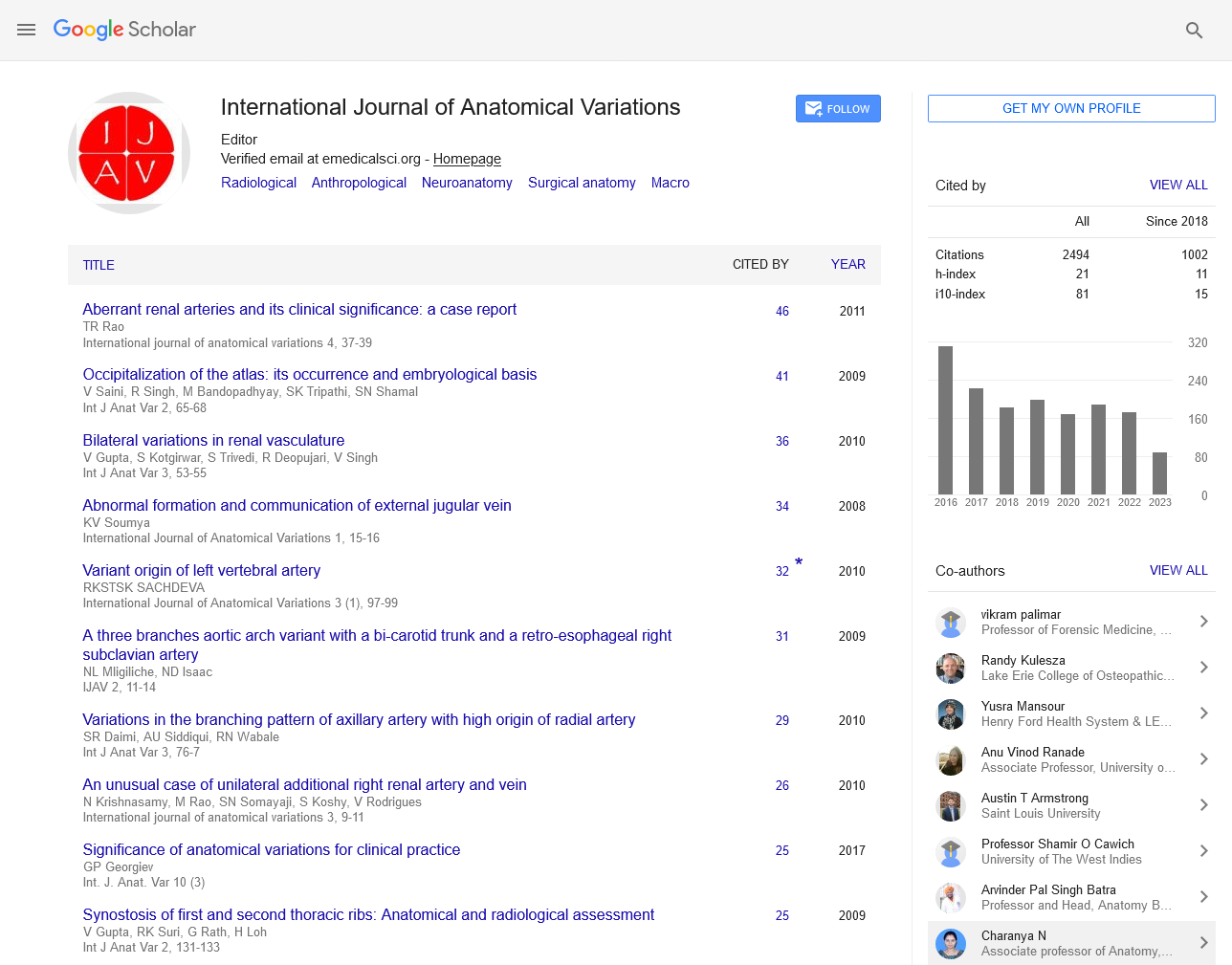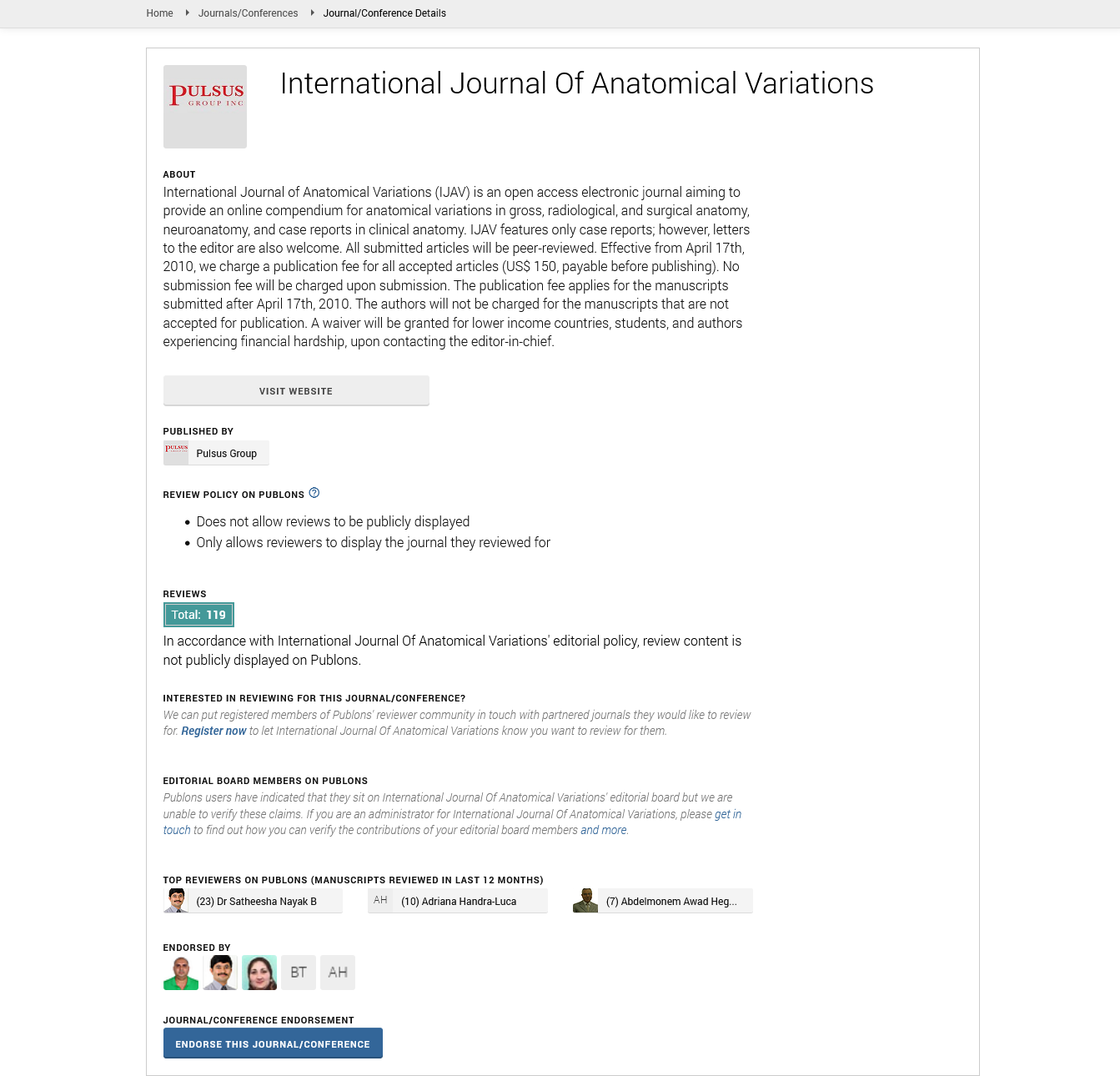Human Anatomy A Comprehensive Exploration of Structure and Function
Received: 01-Feb-2025, Manuscript No. ijav-25-7626; Editor assigned: 04-Feb-2025, Pre QC No. ijav-25-7626 (PQ); Reviewed: 19-Feb-2025 QC No. ijav-25-7626; Revised: 26-Feb-2025, Manuscript No. ijav-25-7626 (R); Published: 28-Feb-2025, DOI: 10.37532/1308-4038.18(2).490
Citation: Kumar A. Human Anatomy A Comprehensive Exploration of Structure and Function. Int J Anat Var. 2025;18(2): 749-750.
This open-access article is distributed under the terms of the Creative Commons Attribution Non-Commercial License (CC BY-NC) (http://creativecommons.org/licenses/by-nc/4.0/), which permits reuse, distribution and reproduction of the article, provided that the original work is properly cited and the reuse is restricted to noncommercial purposes. For commercial reuse, contact reprints@pulsus.com
Abstract
Human anatomy, the scientific study of the body’s structures, provides critical insights into the biological framework that supports life. This article presents a comprehensive overview of human anatomy, detailing major systems including the skeletal, muscular, nervous, circulatory, respiratory, digestive, urinary, reproductive, endocrine, and integumentary systems. By examining the interrelation of these systems, we gain a holistic understanding of the human form and function, which is essential for medical practice, research, and education.
INTRODUCTION
Human anatomy is the cornerstone of medical science and biological understanding. From early dissections by ancient physicians to modern-day 3D modeling and imaging technologies [1], the study of anatomy has evolved significantly. It informs disciplines ranging from physiology and pathology to surgery and medical imaging. This paper explores the structural complexity and interdependence of bodily systems, serving as a foundational reference for further clinical and research-based inquiries [2].
HISTORICAL PERSPECTIVE
Anatomical studies date back to ancient civilizations such as Egypt, Greece, and India. Pioneers like Hippocrates, Galen, and later Andreas Vesalius laid the groundwork for modern anatomy through systematic dissection and documentation. The transition from religious prohibitions to scientific curiosity facilitated anatomical progress, culminating in today's advanced methods like MRI and CT scanning [3].
METHODOLOGY
This review is based on a synthesis of academic texts, peer-reviewed articles, and anatomical atlases. Structures are described in both macroscopic and microscopic contexts, emphasizing functional significance. Comparative analysis across systems is used to illustrate anatomical integration.
BODY SYSTEMS OVERVIEW
Composed of 206 bones in the adult body, the skeletal system provides structural support, facilitates movement, and protects internal organs. It also serves as a reservoir for minerals and houses bone marrow for blood cell production. Over 600 muscles enable voluntary and involuntary movements. Skeletal muscles attach to bones via tendons [4], smooth muscles operate internal organs, and cardiac muscle is exclusive to the heart. The central (brain and spinal cord) and peripheral nervous systems coordinate sensation, thought, movement, and autonomic functions. Neurons transmit electrical impulses, enabling rapid communication throughout the body. This system includes the heart, blood vessels, and blood. It transports oxygen, nutrients, and waste products. The closed-loop system consists of pulmonary and systemic circulations. Facilitating gas exchange, the respiratory tract includes the nasal cavity, pharynx, larynx, trachea, bronchi, and lungs. Oxygen is absorbed, and carbon dioxide is expelled through alveolar diffusion. Beginning at the mouth and ending at the anus, this system processes food into absorbable nutrients and expels waste. Key organs include the stomach, liver, pancreas, intestines, and accessory glands. Responsible for maintaining fluid and electrolyte balance, this system includes the kidneys, ureters, bladder, and urethra. It filters blood and excretes nitrogenous wastes. Sex-specific organs facilitate reproduction. In males, testes and associated ducts are central; in females, ovaries, fallopian tubes, uterus, and vagina are key. Hormonal regulation is critical for function. Glands such as the pituitary, thyroid, adrenal, and pancreas secrete hormones that regulate metabolism, growth, reproduction, and homeostasis. The system operates via chemical messengers. Consisting of the skin, hair, nails, and glands, it protects against environmental hazards, regulates temperature, and synthesizes vitamin D. It is the body’s largest organ system [5].
MICROSCOPIC ANATOMY (HISTOLOGY)
Tissues—epithelial, connective, muscle, and nervous—form the basis of all organs. Histological analysis reveals cellular structures, aiding in diagnosis and understanding of tissue function. For example, the arrangement of epithelial cells varies across organs, influencing absorption, secretion, and protection.
ANATOMICAL VARIATION AND DEVELOPMENT
Human anatomy exhibits considerable variation across individuals due to genetics, age, sex, and environmental factors. Embryological development establishes anatomical templates, while congenital anomalies illustrate deviations. Understanding these variations is essential in clinical practice.
MODERN IMAGING AND ANATOMICAL TECHNIQUES
Technological advances, including X-rays, MRI, CT scans, and ultrasound, have revolutionized anatomical study. 3D reconstructions and virtual dissection tools enhance medical education. Minimally invasive procedures rely heavily on accurate anatomical visualization.
CLINICAL RELEVANCE
Knowledge of anatomy is crucial for diagnosing disease, performing surgery, and administering therapies. Anatomical anomalies can indicate underlying conditions. Surgical approaches are tailored to individual anatomy, and interventions like nerve blocks depend on precise anatomical landmarks.
CHALLENGES AND FUTURE DIRECTIONS
While anatomy is a mature science, emerging areas such as neuroanatomy, molecular anatomy, and systems biology continue to expand our understanding. Integration with genomics and AI may yield personalized anatomical maps. Ethical concerns in cadaveric studies and digital data privacy remain pertinent.
CONCLUSION
Human anatomy remains central to the life sciences. Its intricate organization supports the complex functionality of the human body. Continued study, innovation, and ethical practice are essential to advance anatomical knowledge and its applications in medicine.
REFERENCES
- Inzinger M, Massone C, Arzberger E, Hofmann-Wellenhof R (2013) Hair repigmentation in melanoma. The Lancet 382: 1224.
- Bakan P, Dibb G, Reed P (1973) Handedness and birth stress. Neuropsychologia 11: 363-366.
- Boumba V, Ziavrou K, Vougiouklakis T (2006) Hair as a biological indicator of drug use, drug abuse or chronic exposure to environmental toxicants. Int J Tox 25: 143-163.
- Cappella A, Bertoglio B, Di Maso M, Mazzarelli D, Affatato L et al.(2022) Sexual Dimorphism of Cranial Morphological Traits in an Italian Sample: A Population-Specific Logistic Regression Model for Predicting Sex. Biology 11: 1202.
- Harris JE, Eng JJ (2006) Individuals with the dominant hand affected following stroke demonstrate less impairment than those with the no dominant hand affected. Neuro rehabilitation and neural repair 20: 380-389.
Indexed at, Google Scholar, Crossref
Indexed at, Google Scholar, Crossref






